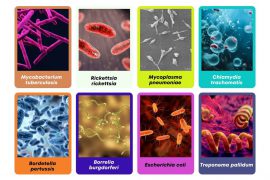Do we assume our students come to university with the language and communication skills to succeed in their studies?
Writing well is a crucial skill for achieving success across all subjects at university and into professional life, but recent analysis of NAPLAN results over a ten-year period shows there has been an overall decline in the level of writing skills in Australian year nine students, with implications for these students currently entering higher education. International students from culturally and linguistically diverse backgrounds may also find writing in English at university level a challenge.
Samantha Clarke and Becky Denham from Educational Innovation talked to Biology educators Tim Lee, Hong Nguyen, and Caitlyn Forster, to find out how they have developed an integrated model of asynchronous scaffolding, targeted feedback and in-person support to develop their students’ writing skills in a large first-year science unit, Human Biology (BIOL1008/1098).
To get us started, could you give us some background – who are your students and what are some specific challenges they encounter?
Tim Lee: Well, it’s a large cohort, over 850, and the Know Your Students report shows that it’s a diverse cohort, but there are some commonalities; while for most students it is their first semester of university, there are some exceptions; some students have done biology in high school, some haven’t. And the degree pathways are also very diverse; some might be going into pharmacy or general biology, some are even doing it as an elective in an Arts degree, and about a quarter of the students are international.
Because this is their first semester, one of the big challenges [for students] is the transition to university – trying to get their heads around how the University works, how to study at university, how to be a student. The other main challenge is dealing with the diverse levels of biology knowledge the students have, being able to pitch material to interest those students who have a lot of experience, while giving an opportunity for less experienced students to be in a place where they can jump in the second year confidently.
How do you incorporate writing support directly into the learning activities and assessments of this unit?
Hong Nguyen: There are three major writing tasks [in the unit], the scientific report and two social biology assessments, which are based on communication to the general public. All the assessment instructions guides and exemplars are accessed online in Canvas.
Students have 3 hours of lectures and 3 hours of practicals and workshops per week. Previously, the workshops were mainly focused on supporting the assessment tasks – going through various aspects of how to approach the assessments. But we have changed the format, so this year, the workshops are used to revise the lecture content, and the support for the assessment, the information and resources are all available for students to do asynchronously, but supported through one-to-one feedback sessions of 15 minutes with a demonstrator before they submit their assignment.
So the support for the writing is done on Canvas followed up with one-to-one feedback sessions – how does this work?
Tim: Hong did a fantastic job this year of developing the asynchronous module for the scientific report. The module has a set of instructions with information and descriptions of all the elements of a scientific report. Students are directed to specific sections of module for guidance on how to go about completing each part, using exemplars and annotations of authentic examples.
Hong: This was developed after a revision of the curriculum in 2021. At that point, we decided to expand on the report module, which we have been building up over the years, based on the areas that we have found that students were struggling with, for example, graphing, or writing in a more scientifically appropriate manner. The benefit of the asynchronous module is that students can go back to it when they need it, and find the part that they most need. And given the large number of students and tutors and demonstrators, it also allows for consistent messaging about the requirements and the structure of the report.
Caitlyn Forster: The modules are also really useful for us as demonstrators scaffolding support in feedback sessions. We only have 15 minutes, so we can’t cover everything, but with these modules, we can direct them to things they can work on at home, and then we can prioritise things they really need our help with in our feedback sessions.

What are the benefits of exemplars? And how do you source suitable exemplars?
Tim: We aim to provide an exemplar that would get close to full marks, but not something that has gone above and beyond; we want students to have an example of something that is a solid effort, but isn’t intimidating. We have a few different ways of providing these; Hong has woven authentic scientific writing into the module and interpreted it for students; we have used genuine student responses from previous years, and for this year, because we changed the assessment and so previous student responses were not relevant, we have written our own exemplars. But if things don’t change, student responses are great because they can give students confidence that they could produce something of similar quality.
Caitlyn: Having exemplars helps students to know the kinds of things they can do, but we need to make sure students are aware that they are just examples, and that they can have their own writing style but still follow the structure they’ve seen in the exemplar. It’s about getting that nice balance so that students still have the creativity of their own style of writing while also writing in a proper scientific report manner or a proper news report style.
The exemplars are handy for support as well because students can pinpoint sections of where they need help; on our discussion board we often get quoted points from exemplars where students have specific questions about parts of the report: How do I write this for my assignment?
How does connecting the three assignments, as well as your one-on-one feedback sessions, support students to develop their writing skills?
Caitlyn: Because the three assignments are linked, students can learn from feedback on errors that they make at the start. We start with a small assignment to get students used to writing in a reasonably good style and learning to do things like referencing correctly. This makes it really easy for us as teachers to work out where students are stumbling, and also how we can assist them in getting their skills better across the assignments.
By having feedback that transfers between assignments, we can also help with aspects of their writing style, and how to write for the correct audience; for the social biology assignments, students are communicating with a general audience, while the scientific report is more about communicating to a scientific audience. We can give feedback across both of those assignments showing the importance of writing in a style that is good for the intended audience.
Is there anything else you’d like to highlight that helps with this approach?
Hong: We also give students an opportunity to request a re-mark. We give them an SRES form to fill out and to mark their own assessment and justify why they think they think they should get a better mark. It’s another opportunity for us to see and evaluate our instructions and what resources could be improved for the following year. It can also be informative for us to how we communicate with the markers themselves about how to give feedback to the students.
What do the students think about the approaches taken in this unit?
Caitlyn: Well, we haven’t got the USS yet, but in practical classes I walk around talking to students. One thing I’ve heard is that they really like the exemplars. And I’ve had multiple students say that this unit specifically has some of the best assignment information available. And a lot of them are already saving lots of this information for future assignments, future classes. And just the fact that it is transferable I think is really helpful.
What advice would you give to other educators looking to embed language and communication skills development into their assessments?
1) Analyse past assessments to improve
Tim: Looking at how the assessment has actually run is invaluable because you can see how students have interpreted the information that you’ve provided; see where they’ve found things hard, and where they’re grasping things more easily, and that that can then feed into the next time. I don’t think there’s any other way that you can get that information other than by actually trying an assessment out. In terms of how we collect this information, looking at the marks is not very useful because there are many reasons students might get a low mark. More useful are comments and questions from students and queries about their mark that show more what the students are thinking; if there are issues that are arising multiple times it means that there is something about the instructions that maybe aren’t clear.
The re-mark process is another good indicator, because there will be components of an assignment where students are requesting a re-mark more often. For us, it was a particular section in the discussion part of the scientific report, so we knew that was something that we need to provide even more support for students, which we were conscious of when developing the writing module.
2) Develop instructions carefully
Tim: We have so many components that we really go over the instructions very carefully, trying to think of how the students interpret this. Is there some other information we could provide? Same with the rubrics, thinking about them really carefully. What kind of responses might we get? Can it fit everywhere? Is this clear for a student what this means? More recently, we’ve tried to have as much of a personal approach as we can in a very big unit by providing the one-on-one sessions; every single student in the course can get more than one consultation before they submit their assignment; we train the staff on how to run those sessions and we make sure that they are on the same page with expectations.
3) Connect with other educators who go on to teach your students
Tim: We recently asked academics who were teaching second- and third-year units what they would like us to be doing more in first year to support our students, fully expecting them to say, students need to understand stats more, or scientific concepts. But they all just said scientific writing. It was a bit of a surprise, but it is good to hear we are putting our efforts into things that are helping the students move through.
Want to know more?
If you are interested in implementing any of the approaches discussed in this post, please don’t hesitate to reach out for further information and insights.





